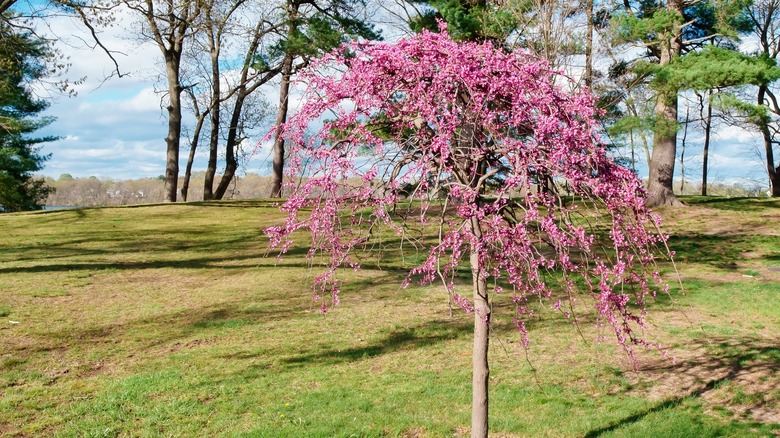If You Like Lavender & Weeping Willows, You'll Love This Graceful Accent Tree
Many people love the aesthetics of lavender and weeping willows. Lavender's purple blooms and soothing scent bring a calming ambiance to any garden, while the weeping willow's graceful, drooping branches are a lovely, serene sight to see. If these plants' beauty also has a special place in your heart, then you'll definitely fall for the lavender twist redbud, too.
The lavender twist redbud, or Cercis canadensis 'Covey,' is a dwarf variety of the Eastern Redbud that grows naturally in eastern and central North America. The tree's cascading branches create a stunning silhouette similar to a weeping willow, while its heart-shaped leaves and purple-pink flowers mimic the beauty of lavender fields in full bloom. It's widely recognized for being an exceptional ornamental plant — it even snagged the 2009 Georgia Gold Medal Award in the tree category. With its distinctive weeping form and vibrant spring blooms, the lavender twist redbud can be a gorgeous focal point or companion plant in your garden. Learn more about this tree's unique beauty and practical benefits, as well as growing and caring for your own.
The beauty and benefits of the lavender twist redbud
One of the tree's appeals lies in its ever-changing beauty across seasons. In early spring, before the leaves emerge, the tree is covered with clusters of vibrant lavender-pink flowers that cling to its branches. However, these blooms are not only beautiful to look at; they also attract pollinators like bees and butterflies. This makes the tree a valuable addition to your garden if you want to support local wildlife. When the flowers drop at the end of spring, their heart-shaped leaves will appear. They'll form a lush green canopy that can provide your plants with shade during the warmer months. Its leaves then become golden in autumn. When winter sets in and the leaves fall, its twisted, bare branches and weeping form will continue to make the tree a standout in your garden.
Besides its beauty, the lavender twist redbud offers practical benefits to both experienced and beginner gardeners. Its compact size makes it suitable for various garden spaces, from small urban yards to expansive landscapes. Typically reaching a height of 5 to 10 feet and a spread of 6 to 8 feet, it can fit into existing garden designs without overshadowing other plants. Plus, since it's hardy in USDA zones 4 to 9, it's adaptable to a range of climates and soil conditions. Additionally, the lavender twist redbud is low-maintenance. It requires minimal pruning and care once the flowers have bloomed, which you'll learn more about below.
Growing and caring for your lavender twist redbud
First, choose a location with full to partial sunlight to ensure the tree produces beautiful, abundant blooms each spring. The tree thrives in soil that drains well, so make sure the soil in your chosen area isn't prone to becoming excessively waterlogged. After you've picked the perfect spot, plant it the way you would any other tree: dig a hole two times as wide and as deep as the tree's root ball, and plant it at the same depth it was in its nursery container. Water thoroughly after planting to help the tree anchor its roots.
Once planted, the lavender twist redbud requires minimal maintenance. You'll need to water regularly during the first year to help the tree develop a strong root system, but mature trees are relatively drought-tolerant. You don't need to prune it, but you can remove any dead or damaged branches to maintain the tree's shape and health. The ideal time to trim any extra branches or growth would be in the spring, right after the flowers have turned into those lovely heart-shaped green leaves. You should also apply a balanced, slow-release fertilizer in early spring to get the best results.


